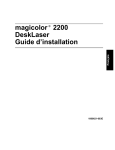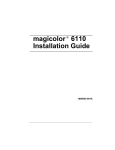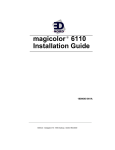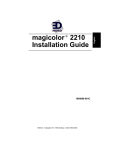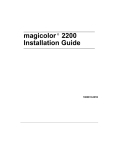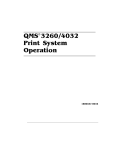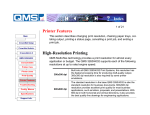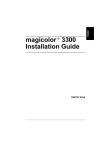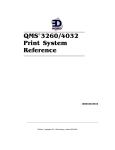Download Minolta Magicolor 2200 Installation guide
Transcript
English magicolor 2200 DeskLaser Installation Guide ® 1800621-001E i Thank You Thank you for purchasing a magicolor 2200 DeskLaser. You have made an excellent choice. Your magicolor 2200 DeskLaser is specially designed for optimal performance in Windows and TCP/IP networking environments. English Trademarks The following are registered trademarks of MINOLTA-QMS, Inc.: QMS, the MINOLTA-QMS logo, and magicolor. Minolta is a trademark of Minolta Co., Ltd. Other product names mentioned in this guide may also be trademarks or registered trademarks of their respective owners. Proprietary Statement The digitally encoded software included with your printer is Copyrighted © 2002 by MINOLTA-QMS, Inc. All Rights Reserved. This software may not be reproduced, modified, displayed, transferred, or copied in any form or in any manner or on any media, in whole or in part, without the express written permission of MINOLTA-QMS, Inc. Copyright Notice This manual is Copyrighted © 2002 by MINOLTA-QMS, Inc., One Magnum Pass, Mobile, AL 36618. All Rights Reserved. This document may not be copied, in whole or part, nor transferred to any other media or language, without written permission of MINOLTA-QMS, Inc. Manual Notice MINOLTA-QMS, Inc. reserves the right to make changes to this manual and to the equipment described herein without notice. Considerable effort has been made to ensure that this manual is free of inaccuracies and omissions. However, MINOLTA-QMS, Inc. makes no warranty of any kind including, but not limited to, any implied warranties of merchantability and fitness for a particular purpose with regard to this manual. MINOLTA-QMS, Inc. assumes no responsibility for, or liability for, errors contained in this manual or for incidental, special, or consequential damages arising out of the furnishing of this manual, or the use of this manual in operating the equipment, or in connection with the performance of the equipment when so operated. Registering the Printer Mail—Fill out and send in the registration card enclosed in your shipment. Internet—Go to www.onlineregister.com/minolta-qms/ and follow the instructions given there. CD-ROM—Follow the instructions on the CD-ROM. ii English Contents Getting Acquainted with Your Printer .......................................................................................1 Features 1 Front/Right Side View 1 Front Internal View 1 Left Side/Rear Side View 2 Documentation Set ........................................................................................................................2 Setting up Your Printer ................................................................................................................3 Shipment Contents 3 Unpacking the Printer 3 Installing the Waste Toner Pack 5 Installing the Fuser Oil Roller 6 Removing the Tape from the Transfer Roller 7 Loading Media 8 Loading the Multipurpose Tray 10 Installing Accessories 11 Plugging in/Turning on the Printer ...........................................................................................12 About the Control Panel .............................................................................................................12 Control Panel Indicators 13 Control Panel Keys 13 Configuration Menu Overview .................................................................................................14 Language 14 Sample Page 15 Engine 15 Network 16 Service 19 Connecting the Printer ...............................................................................................................19 Installing Printer Drivers and Software ...................................................................................20 Plug and Play Printer Driver Installation 20 Manually Installing the Printer Driver/Monitor 20 Selecting the Crown Port 21 Troubleshooting ..........................................................................................................................21 Accessories and Consumables ....................................................................................................23 Accessories 23 Consumables 23 i Regulatory Compliance ..............................................................................................................24 FCC Compliance Statement 25 Canadian Users Notice 25 Laser Safety 25 International Notices 26 English Warranty Considerations ...........................................................................................................26 Consumables and Your Warranty 26 Manufacturer’s Declaration of Conformity—Europe 220 Volt ..............................................27 Manufacturer’s Declaration of Conformity—Latin America 110 Volt .................................28 Manufacturer’s Declaration of Conformity—Latin America 220 Volt .................................29 ii Contents Getting Acquainted with Your Printer Print Speed 5/20* pages per minute SDRAM 32 MB Resolution 1200 x 600 dpi 500-sheet Letter/A4/Legal (Upper Media Tray) Standard Multipurpose Tray Standard Lower Feeder Unit Optional Duplex Unit Optional 5-bin Mailbox Optional 64 MB Memory Expansion Optional English Features *5 = color; 20 = monochrome black The following drawings illustrate the parts of your printer referred to throughout this guide, so please take some time to become familiar with them. Front/Right Side View 1—Output tray 2—Top cover 3—Top cover latch 4—Control panel and message window 5—Front cover latch (one on each side) 6—Front cover 7—Upper media tray (tray also known as a cassette) 8—Right-side cover latch 9—Multipurpose tray (closed) 10—Pull-out carrying bars (one on each side) 11—Upper feed path cover 11 Front Internal View 1—Toner ejection lever 2—Toner slot 3—Toner carousel release button 4—Toner rotation knob 5—Waste toner pack 6—Transfer belt unit right release lever 7—OPC drum cartridge Getting Acquainted with Your Printer 1 Left Side/Rear Side View English 1—Ventilation grille 2—Interface 3—AC power connector 4—Top cover 5—Output tray 6—Main power switch 7—Hand grips for moving printer 8—Media tray (left side) Documentation Set Your magicolor 2200 comes with one CD-ROM. All the documentation is on this CD-ROM unless otherwise noted below. It is provided in Adobe Acrobat PDF format. You may discover movie camera icons in the manuals. If you’re using the Acrobat PDF version of this guide, click the icon to play a QuickTime video clip of the procedure described in the text. Quick Setup Guide Use this sheet when unpacking the printer. Service & Support Guide This lists global sources of service and support for your printer. Further information about MINOLTA-QMS printers is available through the Internet. Installation Guide You’re looking at this document right now. This assists in setting up the printer, installing a printer driver, and connecting to a network. It also briefly describes the control panel and configuration menu. User’s Guide The User’s Guide guides you through the day-to-day operation of your printer, including information on printing files, refilling print media, and replacing toner. It also includes information on handling, cleaning, and maintaining your printer; improving print quality; and troubleshooting printer problems. Maintenance Guide This guide is a handy item to keep at the printer for quick reference information regarding operation and care of the printer. Registration Card 2 Registration and warranty information is included. Documentation Set Setting up Your Printer WARNING! English The printer weighs 87.1 lbs (39.5 kg) without consumables. To avoid injury, at least two people must lift and move the printer. Attention Do not plug in the printer’s power cord before completing all installation steps. Shipment Contents Printer with a 500-sheet letter/A4/legal media tray Consumables kit Fuser oil roller Waste toner pack Power cord Documentation (see “Documentation Set” on page 2) Utilities and Documentation CD-ROM Interface cables aren’t included in the shipment. If you need cables, contact your local vendor or computer store. Unpacking the Printer Save the packing materials in case you ever have to relocate your printer or for future storage. 1 2 3 Remove the protective plastic cover. Remove the tape from the outside of the printer. Take the tape off of the pull-out carrying bars and slide them outward from the printer. Setting up Your Printer 3 4 With another person’s help, lift the printer from the carton, and place it in its intended location. A third person’s assistance may be required if the printer is lifted above waist level. English When lifting and carrying the printer, use the hand grips and the pull-out carrying bars . 5 Open the front cover. Use both hands to avoid putting uneven strain on the front cover hinges. 6 Remove the cardboard/foam spacers and the tape from the laser lens cover. The transfer belt left release lever will move to the 4 o’clock position when you remove the spacers. 7 Pressing on the transfer belt unit front handle with one hand, take the yellow tag attached to the transfer belt unit fixture with your other hand, and pull the fixture straight toward you. This fixture protects the transfer belt during initial transportation. Dispose of the fixture according to your local regulations. 4 Setting up Your Printer Remove the tape holding the toner cartridge carousel in place. 9 Remove the piece of foam attached to the front of the toner cartridge carousel. English 8 Installing the Waste Toner Pack The waste toner pack collects the excess toner remaining on the OPC drum cartridge. 1 2 Remove the waste toner pack from its plastic shipping bag. Make sure the transfer belt unit left release lever is still set to its correct (2 o’clock) position. If the transfer belt unit left release lever is at its top (12 o’clock) position or the laser lens cover is not firmly seated, the waste toner pack cannot be installed. 3 Press the bottom of the waste toner pack into the printer first, then the top, until it is firmly seated. 2 1 4 Close the front cover. Use both hands to avoid putting uneven strain on the cover hinges. Setting up Your Printer 5 Installing the Fuser Oil Roller Push the top cover latch and open the top of the printer . 2 Remove the fuser oil roller from its box. English 1 Attention Lift and hold the fuser oil roller only by the handle. Do not allow the roller surface to contact the table or get dirty. This could lower image quality. 6 3 Rotate the two small levers to the unlocked position. 4 Remove the tape from the media exit area. 5 Insert the fuser oil roller guides into the guide rails, then carefully lower the roller. Setting up Your Printer 6 With the top of the printer open, rotate the two fuser oil roller levers to the locked position. If the fuser oil roller release levers are not correctly set, English the top cover cannot be closed. 7 Close the top cover gently to avoid jarring the fuser oil roller. Removing the Tape from the Transfer Roller 1 Press the right cover release button and open the right cover . 2 Remove the tape from the transfer roller unit. Setting up Your Printer 7 English 3 Make sure the transfer roller unit handles remain in the down position. 4 Close the right cover. Loading Media Loading the Media Tray 8 1 2 Slide out the media tray. 3 Push the media pressure plate down to lock it in position. Remove the tape and the packing material from the media pressure plate. Setting up Your Printer 4 Adjust the media guides to fit the size paper you’re loading. English Squeeze the retainers, move the guides to the appropriate location (media sizes are listed on the tray), and release the retainers. Attention The media should fit easily between the guides. Improperly adjusted guides may cause poor print quality, media jams, or printer damage. 5 Load the media face-up, short edge toward the right of the tray. Often, an arrow on the media package label indicates the printing-side of the media. A fill limit mark is provided on the inside of the tray. The media tray holds 500 sheets of 20 lb bond (75 g/m²) paper. Make sure that the paper fits easily between the guides and the paper corners are under the left and right media-separating tabs and are not bent. For further information about loading and using media, refer to chapter 2, “Using Media,” in the User’s Guide. Setting up Your Printer 9 6 Slide the media tray all the way in. English If you have removed the tray from the printer, slightly tilt up the front of the tray to insert it into the guide rails to slide it back in. 1 Open the multipurpose tray. 2 Open the media support. 3 Load the media face down, short edge toward the printer. Often, an arrow on the media package label indicates the face-up side of the media. 10 FA C DO E WN Loading the Multipurpose Tray Setting up Your Printer English A fill limit mark is provided on the inside of the media guides on the multipurpose tray. The multipurpose tray holds 150 sheets of 20 lb bond (75 g/m²) paper. Attention Load only one type or size of media per tray at a time. 4 Adjust the media guides to fit the size media you’re loading. LTR LG . EXE. L. A5 B5 A4 Attention Always adjust the media guides after inserting the media. A guide that is not properly adjusted can cause poor print quality, media jams, or printer damage. 5 Specify the media size in the multipurpose tray in the printer driver. For further information about loading and using media, refer to chapter 2, “Using Media,” in the User’s Guide. Installing Accessories If you purchased any printer accessories, then install them now. If installation instructions are included with the accessory, follow them. If not, instructions are included in the User’s Guide. A complete list is in “Accessories and Consumables” on page 23. Refer to www.minolta-qms.com or www.q-shop.com for part numbers and pricing. Setting up Your Printer 11 Plugging in/Turning on the Printer 1 Make sure the printer is turned off. 2 Plug the printer power cord into the printer and English into the dedicated, grounded, surge-protected electrical outlet. WARNING! Do not overload the outlet. For products installed outside North America, do not connect the groundwire to gas or water pipes or grounding for telephones. 3 Turn on the printer. After a brief warmup, your printer displays “IDLE” on the message window. If “IDLE” is not displayed in the message window after the power switch is turned on, the setup operation is not proceeding correctly or the printer may be malfunctioning. Recheck the setup. The printer automatically switches to power-saving mode after 60 minutes of inactivity. In the Engine/ Energy Saver menu, you can change the number of minutes before the printer switches to power-saving mode. In compliance with UL guidelines, “The appliance inlet is considered to be the main disconnect device.” About the Control Panel The control panel, located on the front of the printer, allows you to direct the printer’s operation. In addition, it displays the current status of the printer, including any condition that needs your attention. The control panel consists of the following parts: Three indicators (LEDs) to provide printer status information. A message window to display status and configuration information. Seven keys to allow you to control the printer configuration through access to frequently used printer functions. MESSAGE WINDOW 12 Plugging in/Turning on the Printer Control Panel Indicators Indicator Off On The printer is not receiving data. The printer is receiving data from one or more of its interfaces. No problem. The printer requires operator attention (usually accompanied by a status message in the message window). Control Panel Keys Key MP SIZE Function PressOn line First? N/A This key has no function on the magicolor 2200 DeskLaser but is used to set the mutipurpose tray media size on magicolor 2200 Crown printers. Media sizes are controlled through the printer driver on magicolor 2200 DeskLaser printers. Accesses the configuration menu. When you’re changing the printer configura- Yes tion, press this key to cancel a change (before pressing the Select key), to return to the previous selection or option for the current menu and to return to the previous choice when changing character information. The Select key selects a menu or a displayed menu option. Yes Use this key to advance to the next selection for the current menu or to advance to the next choice when changing character information. The Online key switches the printer between online and offline status. Press N/A the key once to take the printer off line when it is on line, and press the key once to return the printer to on line when it is off line. The Cancel key allows you to cancel a print job. No Previous/Next navigation keys allow you go backward or forward through the Yes menu choices. About the Control Panel 13 English The printer is off line and not ready to accept The printer is on line and ready to accept data. data. Configuration Menu Overview Language English Sample Page Engine Network Service Error recovery Energy saver Print density Chain inputbins Chain outputbins IP address HW address Subnet mask Conn. timeout Ethernet speed Default router NMS1 NMS2 NMS3 Page count Clear care Language Status and error messages as well as configuration menus and options can be displayed in the message window in one of the available languages. Menu Language Purpose Change the message window language. Choices Chinese Simplified, Chinese Traditional, Czech, Danish, Dutch, English, French, German, Italian, Japanese, Korean, Portuguese, and Spanish. Default English Selecting a Message Window Language If you want to change the message window language, use the following quick control panel sequence: Press Key (Until) Display Reads Online IDLE (and online LED is off) Menu LANGUAGE Select *ENGLISH Next ( Select 14 ) / Previous ( ) Press the Next and/or Previous key until the language required is displayed <LANGUAGE> IS SELECTED The printer must be restarted for changes to the Language menu to take effect. Configuration Menu Overview Sample Page This menu item initiates the printing of a sample page that can be used to check print quality. Sample Page Purpose Prints a sample page. Choices Yes—Prints a sample page. No—Doesn’t print a sample page. Default Yes English Menu Engine The following menus allow you to configure the hardware control settings of your printer. Error Recovery When the Error Recovery feature is On, the printer will automatically reprint pages that are halted due to media jams or other errors. Menu Engine/Error Recovery Purpose Enables or disables error recovery. Choices On—Reprints a print job from the page on which the jam or error occurred. Off—Don’t reprint a print job when a jam or error occurs. Default On Energy Saver From this menu item you can set the time interval that the printer must remain inactive before it will switch to a state of reduced power consumption. Menu Engine/Energy Saver Purpose Sets the length of inactivity before the printer changes to a low-power state (the engine remains on, but the fuser turns off). Choices 15 minutes, 30 minutes, 1 hour, 2 hours, 3 hours—Idle time before activation of low-power state. Off—Use normal power all the time. Default 30 minutes Notes After the chosen time expires (for example, 30 minutes), the printer enters a low-power mode. The printer remains in low-power mode until a print job is received or until the printer is manually switched from offline to online. After receiving a signal to print or to go on line, the printer warms up and returns to normal power. Print Density This menu item allows you to adjust the amount of toner applied during the printing process. Menu Engine/Print Density [Yellow, Magenta, Cyan, and Black] Purpose Adjusts toner (color) density. Choices -1.6%, -0.8%, 0%, +0.8%, +1.6% (lowest to highest density) Default 0% Configuration Menu Overview 15 Chain Inputbins English This menu item is available only if an optional media cassette is installed. Menu Engine/Chain Inputbins Purpose Allows you to “chain” cassettes (inputbins) so that when the first cassette empties, the printer automatically draws media from the other cassette. Choices On—Switch to the next cassette with the same size and type of media when the default cassette is empty. Off—Don’t switch cassettes; use only the default cassette. Default On Chain Outputbins This menu item is available only if an optional 5-bin mailbox is installed. Menu Engine/Chain Outputbins Purpose Allows you to “chain” mailbox bins (outputbins) so that when the first bin fills, the printer automatically sends output to the next available bin. Choices On—Switch to the next available bin when the default bin is full. Off—Don’t switch bins; use only the default outputbin. Default Off Network The following menu items allow you to configure your printer for connection to your network. IP (Internet) Address The IP Address menu allows you to set the printer’s network (Internet Protocol) address. The address is in the format xxx.xxx.xxx.xxx. Menu Network/Internet address Choices Each xxx.xxx.xxx.xxx triplet can have a value of 001–254. Default 161.033.128.024 Notes This address must be set, and it must be unique. Once you save your changes to this menu, the printer automatically reboots. The address must consist only of numbers and periods. Selecting a letter or another symbol results in an error message. All xxx values must be three digits (for example, 1 is entered as 001, and 10 is entered as 010). HW (Hardware) Address The HW Address menu allows you to view the printer’s factory-default Ethernet hardware address. 16 Menu Network/HW address Choices None (read-only) Default The printer’s hardware address in the form HW:080086 xxxxxx Configuration Menu Overview Subnet Mask Menu Network/Subnet mask Choices Each xxx.xxx.xxx.xxx triplet can have a value of 001–254. Default 000.000.000.000 Notes If subnets are not used with your network, the subnet mask should remain 000.000.000.000. (Check with your network administrator.) This allows the interface to provide automatic sensing of gateways. If you identify a subnet mask, this automatic sensing is disabled. Once you save your changes to this menu, the printer automatically reboots. The address must consist only of numbers and periods. Selecting a letter or another symbol results in an error message. All xxx values must be three digits (for example, 1 is entered as 001, and 10 is entered as 010). Connection Timeout This setting determines the amount of time that the network connection can remain inactive before it is closed. Menu Network/Conn. Timeout Choices 0–999 (seconds) Default 0 Notes A new network connection is established every time a print job is sent to the printer. Ethernet Speed The Ethernet Speed menu allows you to select the Ethernet network speed. Menu Network/Ethernet Speed Choices Autodetect 10MBit–10 Mbit/Sec Half Duplex 100MBit–100 Mbit/Sec Half Duplex Default Autodetect Effectivity Immediately Default Router The Default Router menu allows you to set the Internet address of a router. The address is in the format xxx.xxx.xxx.xxx. Menu Network/Default Router Choices Each xxx.xxx.xxx.xxx triplet can have a value of 001–254. Default 000.000.000.000 Notes If gateways are not used with your network, the router address should remain 000.000.000.000. (Check with your network administrator.) Once you save your changes to this menu, the printer automatically reboots. The address must consist only of numbers and periods. Selecting a letter or another symbol results in an error message. All xxx values must be three digits (for example, 1 is entered as 001, and 10 is entered as 010). Configuration Menu Overview 17 English The Subnet Mask menu allows you to set the printer’s subnet mask. The address is in the format xxx.xxx.xxx.xxx. NMS1–NMS3 SNMP (Simple Network Management Protocol) is a standard protocol used to monitor devices and the networks to which they attach. English The NMS1, NMS2, NMS3 menus allow you to identify and configure up to three Network Management Stations (NMSs). You must provide the following information about each NMS that you want to be able to access the printer: address, community name, and access. NMSx Address The NMS Address option allows you to set the IP (internet protocol) network address for the NMS so the printer can communicate with the network. Traps, if enabled, are sent to this address. The address has the form xxx.xxx.xxx.xxx. Menu Network/NMSx/NMSx Address Choices Each triplet can have a value of 000–255 Default 000.000.000.000 Notes 000.000.000.000 is a wildcard address that allows any host to connect to the printer using the defined community name. The address must consist only of numbers and periods. Selecting a letter or another symbol results in an error message. The printer must be rebooted before changes to this setting will go into effect. Any xxx value between 10 and 99 must begin with 0 (for example, 10 is entered as 010 and 99 is entered as 099). Any xxx value between 1 and 9 must begin with 00 (for example, 1 is entered as 001 and 9 is entered as 009). NMSx Community Name A community is a group of SNMP agents managed by an NMS, and a community name is associated with a specific NMS address. For the NMS to gain access to the device, the correct community name (up to 15 characters in length) must be supplied when connecting. Menu Network/NMSx/NMSx Community Choices Up to 15 characters Default Public Notes The printer must be rebooted before changes to this setting will go into effect. NMSx Access The NMS Access option provides security for the SNMP by configuring the privileges associated with each NMS. 18 Menu Network/NMSx/NMSx Access Choices None—The NMS isn’t configured. Other configured NMS’s can still access the printer via SNMP. Read—The NMS can read all SNMP variables. Read-Trap—The NMS can read all SNMP variables and receive traps. Trap—Traps are sent to the NMS (if defined) when printer errors occur. Write—The NMS can read all SNMP variables as well as set the ones so defined. Write-Trap—The NMS can read all SNMP variables, set the ones so defined, and receive SNMP traps on printer errors. Default Read Note The printer must be rebooted before changes to this setting will go into effect. Configuration Menu Overview The 3 NMS’s are recognized by the printer in sequential order, with NMS1 first and NMS3 last. When a connection is made, the printer looks for a matching IP address assigned to the NMS’s, and stops looking once a match is found. Since the IP address setting of 000.000.000.000 is treated as a wildcard, if NMS1 has this setting, then the other 2 NMS’s have the access assigned to NMS1. If a match isn’t made, then the printer looks for a match with NMS2, and if necessary, NMS3. English Service Service menu items are used to clear service messages and to view the number of faces printed. Page Count This menu item allows you to view the number of pages that have been printed. Menu Service/Page Count Choices None (read-only) Default 0 Clear Care Use this menu item to clear service messages from the control panel message window. Menu Service/Clear Care Choices Yes, No Default No Notes Service messages will be erased from the control panel message window after you select Yes in this menu, and then place the printer back on line. Connecting the Printer 1 The interface panel is located on the left back of the printer. Parallel connection Using a Centronics IEEE 1284 bidirectional parallel cable, connect the parallel port on the printer to the parallel port on your computer. Ethernet connection Parallel port Ethernet port Using a twisted-pair (RJ45) Ethernet cable, connect the Ethernet port on the printer to a 10BaseT/100BaseTX network connection. 2 If necessary, in the Network/IP Address menu, enter the printer’s Internet address. 3 If necessary, in the Network/Subnet Mask menu, enter the printer’s subnet mask. 4 If necessary, in the Network/Default Router menu, enter the Internet address of the default router. Connecting the Printer 19 Installing Printer Drivers and Software The printer driver and additional software found on the Utilities and Documentation CD-ROM can be installed on PCs using any of the following operating systems: — Windows XP English — Windows Me — Windows 2000 — Windows NT4 — Windows 98 — Windows 95(B) Plug and Play Printer Driver Installation 1 2 Ethernet connections don’t support Plug and Play technology. If you’re using an Ethernet network connection, skip to the next section. Under certain PC configurations, the Utilities and Documentation CD-ROM automatically launches its own installation utility. If this should occur during the Plug and Play procedure, cancel the Plug and Play installation and install the driver using the CD-ROM installer for easy access to color management and online documentation. With your PC turned off, turn on the printer (the power switch is on the left side of the printer), and then turn on your PC. A Found New Hardware message appears. Follow the directions for your operating system: Windows Me/98/95 XP/2000/NT4 Insert the Utilities and Documentation CD-ROM. Select Search (Windows 2000/NT4) or Install.....Specific Location (Windows XP) When the Other Locations window appears, choose Select Other Location. Insert the Utilities and Documentation CD-ROM. Select Browse Select CD-ROM Drives De-select all other choices. Locate the Driver directory on the CD-ROM, and then choose OK. Choose Next Follow the instructions on the screen to complete the installation of the printer driver. When the installation is complete, the Windows desktop appears. Remove the CD-ROM from the PC, and store it in a safe place. During software installation you can view online help by choosing the Help button. Manually Installing the Printer Driver/Monitor 1 2 20 If you installed the printer driver using Plug and Play technology, skip this section. Insert the Utilities and Documentation CD-ROM in the CD-ROM drive on your computer. When the installation application window appears, select Install Printer Utility and Driver, and then follow the on-screen instructions. Installing Printer Drivers and Software Selecting the Crown Port 1 2 3 From the Start menu, choose Settings. 4 5 Choose Properties. 6 From the Print To The Following Port list, choose the Crown port that was added during the Crown Print Monitor installation. 7 8 Choose OK to close the Printer Properties window. English The Crown Print Monitor for Windows XP/2000/NT4/Me/98/95 transports print jobs to a print device using the TCP/IP protocol and provides status information to the host. If you installed the Crown Print Monitor, follow the instructions in this section to assign the new Crown port that was created. Choose Printers. In the Printers window click the right mouse button on the magicolor 2200 DeskLaser printer to display the printer’s menu. Choose the Details tab (Windows Me/98/95) or Ports tab (Windows XP/2000/NT4). Close the Printers window. For additional information about the Crown Print Monitor, see the Crown Print Monitor Administrator’s Guide. For information about the print monitor that comes with Microsoft Windows XP/2000, see your Windows documentation. Troubleshooting Although the magicolor 2200 is designed to be highly reliable, you may occasionally experience a problem. The following helps you to identify the cause of the possible installation problems and suggests some solutions related to installation. For additional troubleshooting information, refer to “Troubleshooting” in the User’s Guide. Troubleshooting 21 Symptom Cause English Printer power The power cord is not is not on. correctly plugged into the outlet. Solution Turn the power switch off (O) position, then remove the power cord from the outlet and plug it back in. The power switch is not correctly turned on. Set the power switch to the off (O) position, then set it back to the on (I) position. Something is wrong with the outlet you are using for the printer. Plug another electrical appliance into the outlet and see whether it operates properly. The printer is connected to an outlet Check the voltage and frequency of the outlet. Use a with a voltage or frequency that does power source with the following specifications: not match the printer specifications. —Power Japan: 100 VAC 50–60 Hz 12 amps North America: 120 VAC 50–60 Hz 8 amps Europe: 220-240 VAC 50–60 Hz 6 amps Latin America: 120 VAC 50–60 Hz 8 amps 220-240 VAC 50–60 Hz 6 amps —Voltage fluctuation Japan: 100 VAC ±10% North America: 120 VAC ±10% Europe: 220-240 VAC ±10% Latin America: 120 VAC ±10% 220-240 VAC ±10% —Frequency fluctuation rate within 50/60 ±3 Hz No lights or messages appear on the control panel. There is no power supplied to the AC outlet. Make sure there is power supplied to the AC outlet. The power cord is not plugged in securely into both the power outlet and the printer. Make sure the power cord in plugged in securely both at the power outlet and the printer. The printer power switch is not in the Turn the printer power switch to the On (I) position. On (I) position. The line voltage from the power out- Make sure the line voltage matches the printer’s power let doesn’t match the printer’s power requirements. requirements. You can’t print a sample page. Is the printer off line before you try to Turn the printer off line and then proceed to the Sample enter the Sample Page menu? Page menu selection. The tray does not have media. Check that the media trays are loaded with media, in place and secure. The printer’s covers aren’t closed securely. Make sure the front and top covers are closed securely. Close all covers gently to avoid jarring the printer. Make sure the waste toner pack in installed correctly. There is a media jam. Remove the media jam. The printer is The printer is not on line. not receiving data. (The Data indicator doesn’t blink after a file is sent.) 22 Put the printer on line and check if the message window displays IDLE. Top cover does not close. The fuser oil roller release lever is not set in the correct position. Open the top cover and turn the fuser oil roller release lever (two locations) to the locked position, then close the cover gently to avoid jarring the printer. Front cover does not close. The transfer belt right release lever is not set in the correct position. Turn the right release lever clockwise to the 2 o’clock position, then close the front cover. The waste toner is not set correctly. Remove the waste toner, then reinstall it correctly. Troubleshooting Symptom Cause Waste toner pack cannot be installed. The transfer belt left release lever is Turn the left release lever clockwise to the 2 o’clock not set correctly. position, then install the waste toner. Solution The toner cartridge carousel dial is Toner turned clockwise. cartridge carousel will not turn. Turn the carousel dial counterclockwise. The toner cartridge Toner carousel release button was not cartridge carousel dial pressed. will not turn. Press and release the carousel release button, the turn the carousel dial counterclockwise. A toner cartridge was not inserted in Toner that slot. cartridge carousel slot is empty. Press the toner release button and turn the carousel dial until you reach the empty slot. Install the missing toner cartridge. You do not have to load the toner in a set sequence. The fuser release lever is not set in Fuser oil roller cannot the correct position. be installed. Turn the left release lever clockwise to the 12 o’clock position, then install the fuser oil roller. OPC drum unit cannot be installed. The transfer belt left release lever is Turn the left release lever counterclockwise to the not set to the OPC drum installation 12 o’clock position, then install the OPC drum unit. position. Pages come Media improperly aligned in tray or out skewed. bad media. Check media in trays. The waste toner pack isn’t properly CHECK installed. WASTE TONER message appears in the message window. Make sure the waste toner pack sits snugly against the printer. A consumable item, such as paper or toner, has run out. Handle the message according to the message display. Error message is displayed. A unit or tray is not correctly installed. The media is jammed. A problem occurred inside the printer. Accessories and Consumables Refer to www.minolta-qms.com or www.q-shop.com for part numbers and pricing. Accessories Description Remark(s) 5-bin Mailbox Three models: For 100-, 120-, or 220-volt printers. BuzzBox Via parallel connection for 100, 120, and 220 volts. Dual In-Line Memory Module (DIMM) Additional memory must be a 64 MB, PC-100 Compliant SDRAM DIMM. Duplex Unit Automatic duplexing. Lower Feeder Unit Media tray included. Accessories and Consumables 23 English The laser lens cover is not installed, Reinstall the laser lens cover. or was not installed correctly. English Description Remark(s) Media Tray, 500 Sheet Purchasing extra trays may be convenient when changing media formats and/or media qualities vary. Printer Stand/Cabinet Various models are available. Crown Conversion Kit Converts a magicolor 2200 DeskLaser to a magicolor 2200 Crown printer model. Consumables Description Remark(s) Fuser oil roller FUSER OIL LOW, FUSER OIL EMPTY, or REPLACE OIL ROLLER displays in the message window (after up to 21,000 single-sided continuous monochrome or 7,500 continuous color pages, or 7,000 intermittent [one-page jobs] monochrome or 5,000 intermittent [one-page jobs] color pages). Heavy coverage, intermittent printing, and different media types can use oil at an accelerated rate, reducing fuser and oil roller life. Fuser unit/transfer roller kit REPLACE FUSER displays in the message window (after 100,000 single-sided pages maximum at an equal mix of black and 4-color pages, all with 5% coverage of each color; however, fuser unit life is media dependent). Toner cartridge: Cyan, Magenta, Yellow, and Black <COLOR> TONER EMPTY displays in the message window (after approximately 6,000 single-sided pages per cartridge—black, yellow, magenta, cyan at 5% coverage of each color). OPC drum kit REPLACE DRUM, CHECK WASTE TONER, WASTE TONER NEAR FULL, (OPC drum cartridge, laser lens or REPLACE WASTE TONER displays in the message window (up to 30,000 continuous monochrome* or 7,500 continuous four-color pages, or cover, and waste toner pack) 10,000 intermittent monochrome or 5,000 intermittent color pages). Other factors also affect cartridge life. Transfer belt REPLACE TRANSFER BELT displays in the message window (after 107,000 pages continuous monochrome or 33,000 continuous color pages, or 44,000 intermittent monochrome or 23,000 intermittent color pages). Consumable life is expressed in simplex letter/A4 pages. A duplex page is equivalent to two simplex pages. Regulatory Compliance 24 CE Marking and Immunity Requirements (EU) International (EU) EN 55024 EN 50081-1 EN 61000-3-2 EN 61000-3-3 IEC 61000-4-2 IEC 61000-4-3 IEC 61000-4-4 IEC 61000-4-5 IEC 61000-4-6 IEC 61000-4-8 IEC 61000-4-11 Immunity Characteristics Generic Emission Standard Harmonic Current Emissions Voltage Fluctuations and Flicker ESD Radiated Susceptibility Fast Transients Surge Immunity Immunity to Conducted Disturbance Magnetic Field Immunity Voltage Dips and Variations cTick Mark ACA (Australia) AS/NZS 4251 AS/NZS 3458 Generic Emissions Standard ITE Regulatory Compliance FCC (USA) Title 47 CFR Ch. I, Part 15 Industry Canada (Canada) ICES-003 Issue 3 International (EU) EN 55022 VCCI (Japan) VCCI V-1/98.04 Class B Digital Device (Class A Digital Device with Token-Ring or LocalTalk interface installed) Class B Digital Device (Class A Digital Device with Token-Ring or LocalTalk interface installed) Class B ITE Class A Digital Device with Token-Ring interface installed) Class B ITE (Class A Digital Device with LocalTalk interface installed) Energy Saver ENERGY STAR (USA) ENERGY STAR Compliant Product Safety UL (USA)| cUL (Canada) UL 1950, Third Edition CAN/CSA C22.2 No. 950-93 TUV/GS and CB Scheme International (EU) EN 60950 and IEC 60950 Laser Safety CDRH (USA) Title 21 CFR Ch. I, Subchapter J International (EU) EN 60825-1 FCC Compliance Statement WARNING! Any modifications or changes to this product not expressly approved in writing by the manufacturer responsible for compliance to Federal Regulations could void the user's authority to operate this product within the Laws and Regulations of the Federal Communications Commission. Class B This equipment has been tested and found to comply with the limits for a Class B digital device, pursuant to Part 15 of the FCC Rules. These limits are designed to provide reasonable protection against harmful interference in a residential installation. This equipment generates, uses, and can radiate radio frequency energy and, if not installed and used in accordance with the instruction, may cause harmful interference to radio communications. However, there is not guarantee that interference will not occur in a particular installation. If this equipment does cause harmful interference to radio or television reception, which can be determined by turning the equipment off and on, the user is encouraged to try to correct the interference by one or more of the following measures: Reorient or relocate the receiving antenna Increase the separation between the equipment and receiver Connect the equipment into an outlet on a circuit different from that to which the receiver is connected Consult the dealer or an experienced radio/TV technician for help A shielded cable is required to comply with the limits for a Class B digital device, pursuant to Part 15 of the FCC Rules. Regulatory Compliance 25 English Electromagnetic Emissions (EMI) Class A This is a class B device, but with an optional Token-Ring or LocalTalk interface installed, it changes to a Class A device. English This equipment has been tested and found to comply with the limits for a Class A digital device, pursuant to Part 15 of the FCC Rules. These limits are designed to provide reasonable protection against harmful interference in a commercial environment. This equipment generates, uses, and can radiate radio frequency energy, and if not installed and used in accordance with the instruction manual, may cause harmful interference to radio communications. Operation of this equipment in a residential area is likely to cause harmful interference, in which case the user will be required to correct the interference at his/her own expense. Canadian Users Notice This Class B digital apparatus complies with Canadian ICES-003. Cet appareil numérique de la classe B est conforme à la norme NMB-003 du Canada. Laser Safety This printer is certified as a Class 1 laser product under the U.S. Department of Health and Human Services (DHHS) Radiation Performance Standard according to the Radiation Control for Health and Safety Act of 1968. This means that the printer does not produce hazardous laser radiation. Since radiation emitted inside the printer is completely confined within protective housings and external covers, the laser beam cannot escape from the machine during any phase of user operation. International Notices Power Cord The following power cord requirements are in effect for the 220v magicolor 2200. 2 Minimum 0.75 mm Minimum H05 VV - F The male plug is certified in the country in which the equipment is to be installed, and the female plug is an IEC 320 connector. Voltage Attention Norwegian users: This equipment is designed to operate within an IT power system where the line-to-line voltage does not exceed 240v. Lithium Batteries Attention Swiss users: Lithium batteries need to be disposed of in accordance with Annex 4.1 of SR814.013. Warranty Considerations Various factors can affect a printer’s warranty. Two important ones are consumables and electrostatic discharge. Read your printer warranty carefully. 26 Warranty Considerations Don’t return any merchandise to the manufacturer without calling for a return merchandise authorization (RMA) number. Refer to the Service & Support Guide for the Support telephone number where you can obtain an RMA number. Consumables and Your Warranty Use of consumables not manufactured by MINOLTA-QMS or use of non-supported print media may cause damage to your printer and void your warranty. If MINOLTA-QMS printer failure or damage is found to be directly attributable to the use of non- MINOLTA-QMS consumables and/or accessories, MINOLTA-QMS will not repair the printer free of charge. In this case, standard time and material charges will be applied to service your printer for that particular failure or damage. To order consumables and accessories, go to www.q-shop.com or check the Service & Support Guide for the MINOLTA-QMS office closest to you. Warranty Considerations 27 English If you have any questions, refer to www.minolta-qms.com. Manufacturer’s Declaration of Conformity—Europe 220 Volt We: MINOLTA-QMS Europe B.V. (supplier’s name) English Reactorweg 160, 3542 AD Utrecht, The Netherlands (address) declare under our sole responsibility that the product magicolor 2200 DeskLaser (base product family name) MC2200GDI-2 (model number located on dataplate) 4120 (print engine model/type number) to which this declaration relates is in conformity with the following standard(s) or other normative document(s) EN 60950:1992+A1+A2+A3+A4+A11, CB Scheme in accordance with IEC 60950:1991+A1:1992+A2:1993+A3:1995+A4:1996, CB Certificate No. US-TUVR-0562 EN 60825-1:1994+A11, EN 55022:1998, EN 55024:1998, EN 61000-3-2:1995+A1:1997+A2:1998, EN 61000-3-3:1995, IEC 61000-4-2: 1995+A1:1998 IEC 61000-4-3:1995+A1:1998, IEC 61000-4-4:1995, IEC 61000-4-5:1995, IEC 61000-4-6:1996, IEC 61000-4-8:1993 and IEC 61000-4-11:1994 (title and/or and number and date of issue of the standard(s) or other normative document(s)) (if applicable) following the provisions of 73/23/EEC, 89/336/EEC Directive(s). Utrecht, The Netherlands—November, 2000 (place and date of issue) 28 Manufacturer’s Declaration of Conformity—Europe 220 Volt Manufacturer’s Declaration of Conformity—Latin America 110 Volt We: MINOLTA-QMS, Inc. English (supplier’s name) One Magnum Pass, Mobile, Alabama, USA, 36618 (address) declare under our sole responsibility that the product magicolor 2200 DeskLaser (base product family name) MC2200GDI-1 (model number located on dataplate) 4120 (print engine model/type number) to which this declaration relates is in conformity with the following standard(s) or other normative document(s) UL 1950 Third Edition, 1995; cUL CAN/CSA C22.2 No. 950-M95; FCC Class B Digital Device Title 47 CFR Ch. I., Part 15; FCC Class A Digital Device Title 47 CFR Ch. I., Part 15 applies for systems configured with Token-Ring or LocalTalk interface installed; Industry Canada ICES-003 Issue 3 Class B Digital Device; Industry Canada ICES-003 Issue 3 Class A Digital Device applies for systems configured with Token-Ring or LocalTalk interface installed; EPA ENERGY STAR Office Equipment Program; CDRH Laser Safety Title 21 CFR Ch. I., Subchapter J; MSDS Title 29 CFR Ch. XVII, Part 1910.1200. (title and/or and number and date of issue of the standard(s) or other normative document(s)) (if applicable) following the provisions of N/A Directive(s). Mobile, Alabama, USA—November, 2000 (place and date of issue) Manufacturer’s Declaration of Conformity—Latin America 110 Volt 29 Manufacturer’s Declaration of Conformity—Latin America 220 Volt We: MINOLTA-QMS, Inc. English (supplier’s name) One Magnum Pass, Mobile, Alabama, USA, 36618 (address) declare under our sole responsibility that the product magicolor 2200 DeskLaser (base product family name) MC2200GDI-2 (model number located on dataplate) 4120 (print engine model/type number) to which this declaration relates is in conformity with the following standard(s) or other normative document(s) EN 60950:1992+A1+A2+A3+A4+A11, CB Scheme in accordance with IEC 60950:1991+A1:1992+A2:1993+A3:1995+A4:1996, CB Certificate No. US-TUVR-0562 EN 60825-1:1994+A11, EN 55022:1998, EN 55024:1998, EN 61000-3-2:1995+A1:1997+A2:1998, EN 61000-3-3:1995, IEC 61000-4-2:1995+A1:1998, IEC 61000-4-3:1995+A1:1998, IEC 61000-4-4:1995, IEC 61000-4-5:1995, IEC 61000-4-6:1996, IEC 61000-4-8:1993, and IEC 61000-4-11:1994 (title and/or and number and date of issue of the standard(s) or other normative document(s)) (if applicable) following the provisions of 73/23/EEC, 89/336/EEC Directive(s). Mobile, Alabama, USA—November, 2000 (place and date of issue) 30 Manufacturer’s Declaration of Conformity—Latin America 220 Volt


































